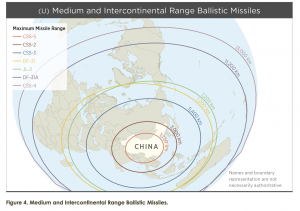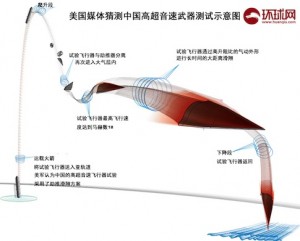Despite all the attention paid to China’s island-building campaign and newly acknowledged naval ambitions, perhaps the most interesting discussion in the latest China Military Power report released earlier this month was the discussion of China’s nuclear forces.
Indeed, China is also the only legally recognized nuclear weapons state whose nuclear arsenal is growing in terms of numbers, diversity, and capabilities.
According to the Pentagon, China has 50-60 land-based intercontinental ballistic missiles (ICBMs).
This is a doubling over the longstanding estimate that China possessed only two dozen or so long-range ballistic missiles capable of reaching the Continental United States.
The Chinese ICBM portfolio includes the silo-based liquid-fueled CSS-4 Mod 2 and Mod 3 (DF-5); the solid-fueled, road-mobile CSS-10 Mod 1 and 2 (DF-31 and DF-31A); and the shorter-range CSS-3 (DF-4).
China also has many nuclear-armed liquid-fueled CSS-2 intermediate-range ballistic missiles (IRBM) and road-mobile, solid-fueled CSS-5 (DF-21) MRBM for regional missions, such as attacking Taiwan, Japan, or U.S. bases in northeast Asia.
The Second Artillery Corps, which controls the PLA’s strategic as well as conventionally armed land-based missiles, also has not neglected its enabling capabilities; it has enhanced its mobility, concealment, command, control, and communications.
According to the report,
These capabilities improve the Second Artillery Force’s ability to command and control multiple units in the field.
Through the use of improved communications links, the ICBM units now have better access to battlefield information, uninterrupted communications connecting all command echelons, and unit commanders are able to issue orders to multiple subordinates at once, instead of serially, via voice commands.
Furthermore, the PLA Navy will soon obtain a sufficient number of strategic submarines to keep at least one of them on patrol at all times with a long-range, nuclear-armed ballistic missile able to attack the United States.
The Pentagon expects that China will double its current fleet of JIN-class SSBN (Type-094) and deploy as many as eight of them by the end of this decade as well as develop a more advanced Type-096 SSBN in the future.
China is also finalizing development of a CSS-NX-14 (JL-2) submarine-launched ballistic missile (SLBM) with an estimated range of 7,400 km.
According to the Pentagon, “Together these will give the PLA Navy its first credible long-range sea-based nuclear capability.”
Most interesting, the Pentagon now believes that China is equipping at least some of its DF-5s with multiple independently targetable re-entry vehicle (MIRV) and that China is likely developing a new road-mobile ICBM, the CSS-X-20 (DF-41), that may be able to deliver MIRVs.
The Pentagon ascribes defensive motives to China’s decisions to acquire more mobile warheads; to keep adding to its silo-based force; to deploy new command, control, and communications capabilities; and to miniaturize its nuclear warheads so as to place several of them on a single missile along with heavier decoys.

These steps are to “ensure the viability of China’s strategic deterrent in the face of continued advances in U.S. and, to a lesser extent, Russian strategic ISR, precision strike, and missile defense capabilities.”
(The report enigmatically adds without explanation that “India’s nuclear force is an additional driver behind China’s nuclear force modernization.”)
The Chinese also explain their unique operational practices—such as hiding some nuclear systems in tunnels and refusing to disclose the precise number of Chinese nuclear warheads or strategic delivery systems—as designed to enhance the survivability of its ICBM force.
The Pentagon report states that the PLA is specifically developing new technologies—“including maneuverable reentry vehicles (MaRV), MIRVs, decoys, chaff, jamming, and thermal shielding” as well as hypersonic glide vehicles and “training exercises featuring maneuver, camouflage, and launch operations under simulated combat conditions–to overcome adversaries’ ballistic missile defense (BMD) systems.
As far as we can tell, China still keeps its land-based ICBM fleet at a low peacetime alert level, with the warheads stored separately from the missiles.
However, Unlike China’s land-based missiles, the missiles on the submarines are mated with their warheads, requiring China to develop, for the first time, new command and control and personnel reliability arrangements to ensure positive control over the submarine’s actions.
After they leave their base at Hainan Island in the South China Sea, Chinese submarine captains may have the pre-delegated authority to launch nuclear missiles if they lose communication with the Chinese high command.
The growing number of Chinese ICBMs also will require China to upgrade its nuclear command and control systems and procedures.
This problem becomes even more serious when one considers that, as the report notes, “The development of China’s conventionally armed missile capability has been extraordinarily rapid,” with the current fleet of short-range systems (less than 1,000 km) exceeding 1,200 systems by the end of last year.

China’s Communist Party-affiliated Global Times newspaper published a graphic showing the potential flight of China’s test of a hypersonic glide vehicle. Credit: Free Beacon
Furthermore, the Pentagon report notes continuing uncertainty regarding China’s declared “no first use” (NFU) policy—which means that “China will never use nuclear weapons first against any nuclear-weapon State, and China will never use or threaten to use nuclear weapons against any non-nuclear-weapon State or nuclear-weapon-free zone.”
But some Chinese officers have publicly suggested that China should consider employing nuclear weapons first if an adversary’s non-nuclear attack threatened the survival of China’s nuclear force or of the PRC regime.
Such a caveat would be problematic since the Second Artillery co-locates nuclear and conventional forces and their command and control systems.
How should the United States respond to China’s new capabilities?
The United States can still discourage China’s use of nuclear weapons without having to rely on an unenforceable NFU policy by strengthening its own nuclear forces to deny China good options to escalate to nuclear war to counter conventional defeats.
To achieve this escalation control, the U.S. military needs updated nuclear delivery vehicles with capabilities for lower yields, rapid delivery, and high accuracy to have viable nuclear options with lower risk of escalation.
It also needs more flexible and secure command and control systems that are secure against Chinese cyber, ASAT, and other degradations (which requires both countermeasures and redundancy) and the capacity to apply tailored limited nuclear strikes against various targets.
The Pentagon also requires an improved capacity for adaptive and short-notice planning for nuclear scenarios, especially theater-based ones, as well as more realistic joint planning and exercises involving other COCOMS besides Strategic Command.
One gets the impression that, when confronted with nuclear scenarios, U.S. regional commands simply presume that STRATCOM will take care of the issue without realizing that how they execute even conventional war plans—especially their war aims but also their means to achieve them–could contribute to nuclear escalation by an adversary.
Beyond the Pentagon, non-DOD agencies need to consider the political and economic implications of possible nuclear weapons use by any party.
We must make sure that local allied and U.S. war plans are sufficiently harmonized.
We don’t want to have a situation in say North Korea, when the United States is striving for escalation control regarding China and the South Koreans are trying to destroy the regime and reunify the country.
And we require many more F-35s in order to be able to suppress China’s robust air defenses and improving capabilities for GPS jamming, and to have good enough tactical ISR to be able to destroy even mobile targets with conventional weapons, thus reducing our need to ever use nuclear weapons first.
The more capable U.S. nuclear and conventional forces, the less likely the United States or its allies will ever have to fight a nuclear war



Leave a Reply